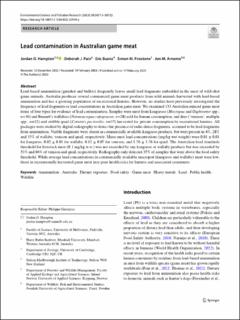| dc.contributor.author | Hampton, Jordan O. | |
| dc.contributor.author | Pain, Deborah J. | |
| dc.contributor.author | Buenz, Eric | |
| dc.contributor.author | Firestone, Simon M. | |
| dc.contributor.author | Arnemo, Jon Martin | |
| dc.coverage.spatial | Australia | en_US |
| dc.date.accessioned | 2023-10-03T12:45:54Z | |
| dc.date.available | 2023-10-03T12:45:54Z | |
| dc.date.created | 2023-03-22T13:59:10Z | |
| dc.date.issued | 2023 | |
| dc.identifier.citation | Environmental Science and Pollution Research International. 2023, . | en_US |
| dc.identifier.issn | 0944-1344 | |
| dc.identifier.uri | https://hdl.handle.net/11250/3093813 | |
| dc.description.abstract | Lead-based ammunition (gunshot and bullets) frequently leaves small lead fragments embedded in the meat of wild-shot game animals. Australia produces several commercial game meat products from wild animals harvested with lead-based ammunition and has a growing population of recreational hunters. However, no studies have previously investigated the frequency of lead fragments or lead concentrations in Australian game meat. We examined 133 Australian minced game meat items of four types for evidence of lead contamination. Samples were meat from kangaroos (Macropus and Osphranter spp.; n=36) and Bennett’s wallabies (Notamacropus rufogriseus; n=28) sold for human consumption, and deer (‘venison’; multiple spp.; n=32) and stubble quail (Coturnix pectoralis; n=37) harvested for private consumption by recreational hunters. All packages were studied by digital radiography to detect the presence of radio-dense fragments, assumed to be lead fragments from ammunition. Visible fragments were absent in commercially available kangaroo products, but were present in 4%, 28% and 35% of wallaby, venison and quail, respectively. Mean meat lead concentrations (mg/kg wet weight) were 0.01 ± 0.01 for kangaroo, 0.02 ± 0.01 for wallaby, 0.12 ± 0.07 for venison, and 1.76 ± 3.76 for quail. The Australian food standards
threshold for livestock meat (0.1 mg/kg w.w.) was not exceeded by any kangaroo or wallaby products but was exceeded by 53% and 86% of venison and quail, respectively. Radiography only detected 35% of samples that were above the food safety threshold. While average lead concentrations in commercially available macropod (kangaroo and wallaby) meat were low, those in recreationally harvested game meat may pose health risks for hunters and associated consumers. | en_US |
| dc.language.iso | eng | en_US |
| dc.rights | Navngivelse 4.0 Internasjonal | * |
| dc.rights.uri | http://creativecommons.org/licenses/by/4.0/deed.no | * |
| dc.subject | ammunition | en_US |
| dc.subject | Australia | en_US |
| dc.subject | dietary exposure | en_US |
| dc.subject | food safety | en_US |
| dc.subject | game meat | en_US |
| dc.subject | heavy metals | en_US |
| dc.subject | lead | en_US |
| dc.subject | public health | en_US |
| dc.subject | wildlife | en_US |
| dc.title | Lead contamination in Australian game meat | en_US |
| dc.type | Peer reviewed | en_US |
| dc.type | Journal article | en_US |
| dc.description.version | publishedVersion | en_US |
| dc.rights.holder | © The Author(s) 2023 | en_US |
| dc.subject.nsi | VDP::Landbruks- og Fiskerifag: 900 | en_US |
| dc.source.pagenumber | 10 | en_US |
| dc.source.journal | Environmental Science and Pollution Research International | en_US |
| dc.identifier.doi | 10.1007/s11356-023-25949-y | |
| dc.identifier.cristin | 2136166 | |
| cristin.ispublished | true | |
| cristin.fulltext | original | |
| cristin.qualitycode | 1 | |

